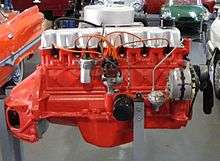Chrysler Hemi-6 Engine
The Chrysler Hemi-6 engine is a family of inline six-cylinder petrol engines produced by Chrysler Australia in three piston displacements and multiple configurations. Hemi-6 engines were installed in Australian-market Chrysler Valiants from 1970 through 1981.
Development and release
Chrysler Corporation in the US had been working since 1966 on an inline 6-cylinder engine, called the D-engine, to replace the Slant 6 (G-engine) in Dodge trucks, but abandoned the effort. Chrysler Australia wanted a new six-cylinder engine for use in the Australian Chrysler Valiant, and so Chrysler USA sent a prototype engine to Chrysler Australia's engineers to continue developing the D-engine. The first 245 cu in (4.0 L) variant was released for the 1970 model year in the VG-model Valiant.
In a major coup for the company, Chrysler Australia's ad agency, the Young & Rubicam Advertising Agency in Adelaide, South Australia, secured the services of British racing driver Stirling Moss to promote the new Hemi-6 (245 cui) in 1969. The agency managed to fly Moss to Adelaide in secret for the advertising campaign, surprising Chrysler Australia's executives. Young & Rubicam's parent company were also the advertising agents for the Chrysler Corporation in the US.
Engineering and design features
The Hemi-6 is a pushrod O.H.V. (overhead valve) engine, with combustion chambers comprising about 35% of the top of the globe. This creates what is known as a low hemispherical shaped chamber. Although the Hemi-6 does not contain truly hemispherical combustion chambers, the "Hemi" moniker was used primarily for its marketing cachet based on the reputation of Chrysler's 1950s-1970s (true) Hemi V8 engines.
The Hemi-6 valves are 18 degrees (included angle) along the crankshaft axis opposed valves, with intake valves as large as 1.96". The 6 intake and 6 exhaust valves open toward each other, and into the center of the combustion chamber. In addition, both valves are slightly inclined across the crankshaft axis (similar to a conventional "wedge" chamber). The cylinder head is a non-crossflow design, meaning the 6 intake and 6 exhaust ports are on the same (left, Australian and British passenger's side) of the engine.
Unlike Chrysler's contemporaneous hemi V8 engines, the Hemi-6's rocker arms are mounted on individual studs (similar to the Chevrolet "big block" V8), rather than on 2 separate rocker shafts as in all 1951-58 Hemis—Dodge, DeSoto, Imperial, and Chrysler "Firepower" and 1964-'71 426 V8s.
All Hemi-6s share a robust crankshaft supported by seven main bearings, and this family of engines quickly developed a reputation for excellent performance, economy, and durability.
The Australian Hemi engines were designed by a five-man team which included the late Maurice Harcus.
Versions and variants
245 cu in (4.0 L)

The 245 was the initial version of the Hemi-6 engine. It was first used in the 1970 VG-model Valiant, and was available clear through to the final CM model of 1981.
Specifications (for 1bbl carbureted variant):
- Bore Size: 3.76 in (95.5 mm)
- Stroke: 3.68 in (93.5 mm)
- Compression ratio: 9.5:1
- Power: 165 hp (123 kW) @ 4600 rpm
- Torque: 235 lb·ft (318 Nm) @ 1800 rpm
- Intake valve head diameter: 1.845 in (46.9 mm)
- Exhaust: 1.500 in (38.1 mm)
245LC (Low Compression) released in 1977
- Bore Size: 3.76 (95.5 mm)
- Stroke: 3.68 (93.5 mm)
- Compression ratio: 7.6:1
- Power: 130 hp (97 kW) estimate
- Torque: 180 lb·ft (240 N·m) estimate
- Intake valve head diameter 1.845 inch (46.9 mm)
- Exhaust valve head diameter 1.500 inch (38.1 mm)
265 cu in (4.3 L)
The 265 was introduced in 1971 in the VH. It used a new cylinder block with a bigger bore diameter of 3.91 in (99.3 mm)—the same as many of the Chrysler small-block V8s—and a new cylinder head, having slightly more hemispherical shaped combustion chambers with larger valves.
The standard version of the 265 produced 203 hp (151 kW) @ 4600 rpm and 262 lb·ft (355 N·m) of torque @ 2800 rpm.
The top of the line performance engine in the E49 Chargers produced 302 hp (225 kW) @ 5600 rpm and 320 lb·ft (434 N·m) of torque @ 4400 rpm. The increased power is due mainly to a more aggressive camshaft, high-load valve springs, triple 45 mm DCOE Weber sidedraught carburetors, tuned-length exhaust headers and a higher compression ratio of 10.0:1.
Specifications (for 2bbl carbureted variant):
- Bore Size: 3.91 in (99.3 mm)
- Stroke: 3.68 in (93.5 mm)
- Compression ratio: 9.5:1
- Power: 203 hp (151 kW) @ 4600 rpm
- Torque: 262 lb·ft (355 Nm) @ 2800 rpm
- Intake valve head diameter: 1.96 in (49.8 mm)
- Exhaust: 1.60 in (40.6 mm)
215 cu in (3.5 L)
This economy-orientated version of the Hemi 6 was released as a running change in early 1971 as the base model engine in the VH Valiant. This engine shares the same stroke length as the other engines but has a smaller bore size of 3.52 inches (89 mm) and lower compression ratio of 8.0:1. It ran on regular petrol and produced 140 hp (104 kW) at 4400 rpm and 200 lb·ft (270 N·m) of torque at a low 1800 rpm.
Specifications:
- Bore Size: 3.52 in (89.4 mm)
- Stroke: 3.68 in (93.5 mm)
- Compression ratio: 8.0:1
- Power: 140 hp (104 kW) @ [4400] rpm
- Torque: 200 lb·ft (270 Nm) @ [1800] rpm
- Intake valve head diameter: 1.835 in (46.6 mm)
- Exhaust valve head diameter: 1.500 in (38.1 mm)